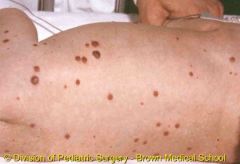![]()
![]()
![]()
Use LEFT and RIGHT arrow keys to navigate between flashcards;
Use UP and DOWN arrow keys to flip the card;
H to show hint;
A reads text to speech;
13 Cards in this Set
- Front
- Back
|
Infantile hemangiomas are the most common tumor of infancy (2%)... what are the risk factors for development? |
Caucasian Prematurity Female Intrauterine procedures (disruption of utero placental circulation though to be the triggering event) Advanced maternal age |
|
|
What is the normal clinical course of infantile hemangiomas? |
Presents at birth or first few weeks of life as a faint erythematous macule --> rapid enlargement over several months, followed by slow involution over years, often leaving textural changes **involution occurs by apoptosis |
|
|
GLUT1+ entities include: |
infantile hemangiomas verrucous hemangioma perineuroma |
|

Clinical syndromes with infantile hemangiomas include: multiple disseminated cutaneous hemangiomas (benign neonatal hemangiomatosis) What do we monitor? |
Good prognosis- mostly cutaneous involvement U/S liver--> greater than 5 cutaneous lesions impart a 16% chance of liver involvement, leading to hypothyroidism check TSH--> MR and cardiac failure can ensue if hypothyroidism not detected ** |
|
|
Clinical syndromes with infantile hemangiomas includes: diffuse neonatal hemangiomatosis (disseminated neonatal hemaniomatosis) Mortality rate? Causes? |
This has both cutaneous and visceral involvement
Mortality rate reported up to 60%, death d/t high output cardiac failure d/t AV shunts (often in liver), CNS complications, and bleeding d/t Kasabach-Merritt syndrome |
|
|
What does PHACES stand for? |
Posterior fossa malformation Hemangioma Arterial anomalities Cardiac anomalies Eye abnormalities Sternal cleft/Supraumbilical raphe |
|
|
What does PELVIS stand for? |
Perineal hemangioma External genitalia maformations Lipomyelomeningocele Vesicorenal abnormalities Imperforate anus Skin problems |
|
|
What does SACRAL stand for? |
Spinal dysraphism Anogenital anomalities Cutaneous anomalies Renal/urologic anomalities Angioma of Lumbosacral localization |
|
|
What does LUMBAR stand for? |
Lower body infantile hemangiomas Urogenital anomalies Myelopathy Bony deformaties Anorectal malformations Arterial anomalies Renal anomalies |
|
|
What are the indications for treatment of an infantile hemangioma? |
Ulceration Bleeding Risk of permanent disfigurement Obstruction of vision Airway obstruction High output cardiac failure |
|
|
What should be monitored in patients receiving a beta blocker for their infantile hemangioma? |
HR BP Patients should be monitored with HR/BP at baseline, at 1 and at 2 hours after dose |
|
|
IH vs RICH vs NICH? |
IH: develops during infancy rapidly during first few months, then involutes, premature females, GLUT1+ RICH: M=F, intrauterine growth fully developed at birth and involutes rapidly in first few months, see associated thrombocytopenia, low fibrinogen, elevated fibrin degradation products, GLUT1-, Lewis Y- NICH: M>F, present at birth, proportional growth, does not involute, GLUT1- |
|
|
Vascular neoplasm associated with POEMS syndrome? What is POEMS syndrome? |
Glomeruloid Hemangioma Polyneuropathy Organomegaly (hepato, lymphadeno) Endocrinopathy (impotence, gynecomastia, amenorrhea, hypothyroid) M protein (a/w castlesmans disease) Skin changes (hemangiomas>hyperpigmentation >skin thickening) |

